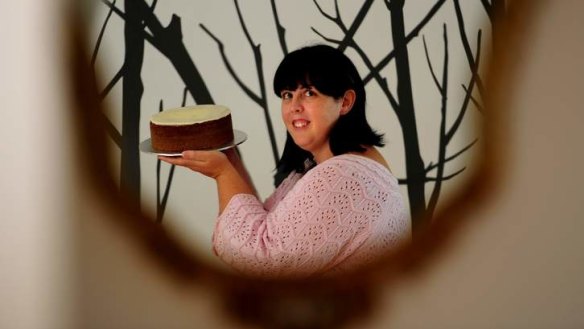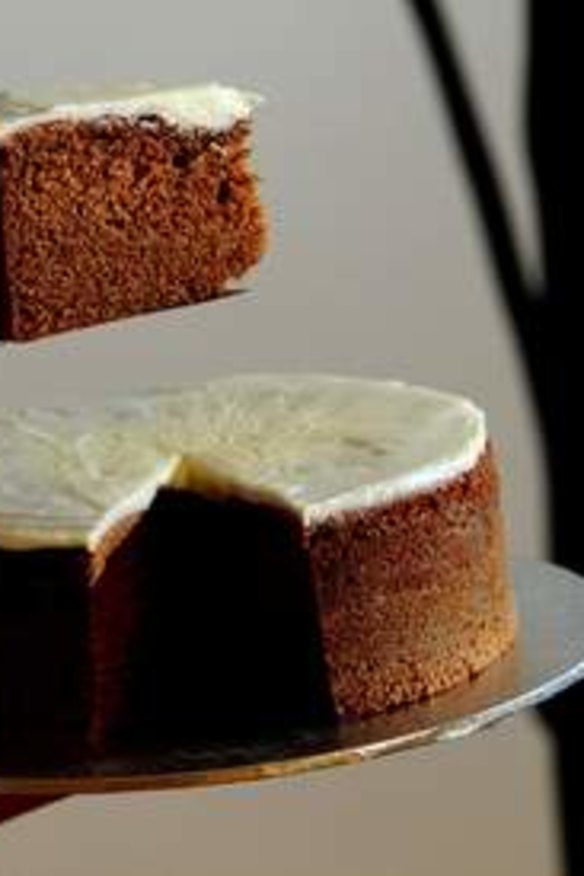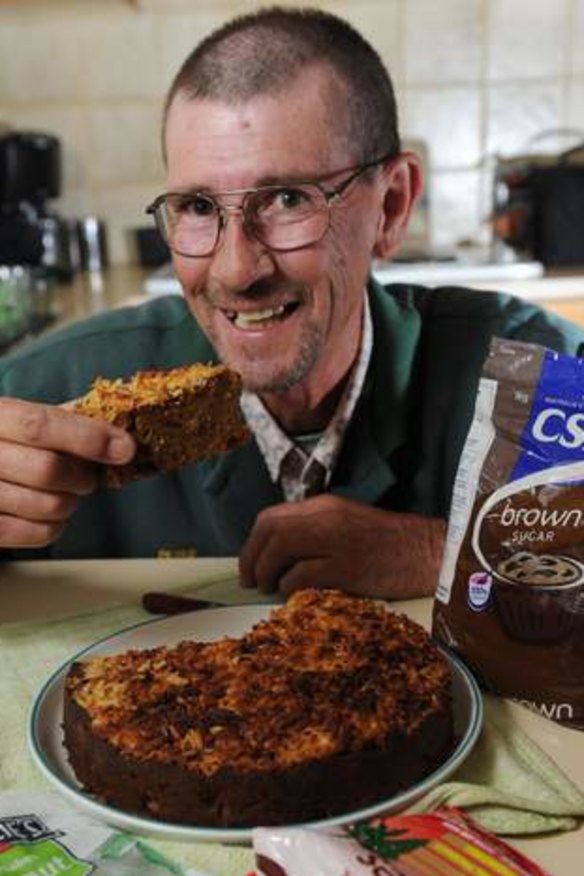Baking just for show
A prize-winning cake is no simple matter.

Strict judges pacing along an aisle of trestle tables brandishing measuring tapes and score charts. Mention the Royal Canberra Show cooking competition and this might be what comes to mind. While the reality is rather more informal, the rules are every bit as tough.
Most of the 24 categories of cake competition allow little variation. Icing is allowed in some categories, not in others. Where it's permitted, icing is allowed on the top only, no hiding disasters by covering the sides. Strictly no decoration is allowed. Twenty centimetres is specified as the height measurement for many cakes while 250 grams of butter is the limit in others - the fruit cake, the plum pudding, the sultana cake. It's mock cream in a chocolate sponge sandwich and cornflower for a plain sponge sandwich. Packet cake mixes are not accepted in most categories.
Marks from cooling racks are frowned on. And cakes are to be presented on a foil-covered board about five centimetres larger than the cake, with ''small feet'' glued on the underside of the board.

Karen Drummond, of Charnwood, says she was apprehensive about entering the show at first.
"I'd always watched the cooking section and was a bit scared of the Country Women's Association ladies as they're pretty tough," she says.
"But last year I got two third places, for my tea cake and chocolate cake."

Drummond has won the grand champion ribbon for her homemade honey twice but she says she was probably more excited about her two third-place ribbons for baking.
On Thursday, February 21, she joins an increasing number of amateur cooks in the show's baking competitions amid a revival in interest. Chief steward Chris Tarlinton, who has worked at the show for more than 30 years, says entry figures are about double those of two decades ago. First-time competitors are on the rise, she says.
Last year, 429 entries were received for the cooking sections of the show, up from 317 the year before and 227 in 2010. Jam entries soared from 148 in 2011 to 283 last year. This year, a new bread contest is also part of the mix, and there are open and novice categories for a cake to mark the city's centenary - a category that has attracted about eight entrants.
Tarlinton says standards have also improved considerably, a change she puts down to the open judging where competitors can watch their cakes being judged and ask questions (the public is also welcome from 10.30am tomorrow).
Classes that teach techniques for orange cake, chocolate cake and fruit cake have been held regularly over the years, but Tarlinton says organisers try to move with the times and include categories reflecting what people are currently baking.
''In saying that,'' she adds, ''we must look at the keeping quality of the cakes, as they have to remain on show for four days in all sorts of weather conditions.''
Among Drummond's six entries this year is a spice cake in the heritage category. The cake is flavoured with an aromatic mix of cloves, cinnamon and nutmeg.
Many cooks use the heritage category to pay homage to recipes they grew up with. This is the case for Drummond, who spent months looking for the perfect recipe. She remembered an old cookbook used by her grandmother she says was dated from "just after World War II".
Drummond had to make a few changes to her spice cake recipe from the original. The cooking time differs vastly due to today's speedier ovens and Drummond ignores the direction to stir the batter with "300 strokes of a spoon".
After many practice cakes, Drummond says she thinks she's finally got the recipe right. And just as well, as she is hoping to scoop the top prize.
"I was inspired to enter because the heritage cake that won last year won the all-over competition," Drummond says.
But for others, winning a ribbon in one of the cooking competition's 24 sections isn't the main motivation to enter. Casey couple Paul and Loryn Reynolds are entering cakes to maintain a family tradition. Loryn's mother, Merran Hunter, has been baking show cakes for more than 30 years and is now the show's cookery steward.
Loryn Reynolds first entered the show as a child. Juniors are encouraged to submit simple dishes such as chocolate chip cookies or arrowroot biscuits decorated with icing and sweets.
Now, she is motivated to beat her mum. Like Drummond, Reynolds is entering six categories: steamed fruit pudding, banana cake, marble cake, chocolate cake, sponge cake and ginger cake.
"It's not a big thing for me to win, but if I was to beat mum and she came second, it would give her great pleasure and me a few bragging rights," Reynolds says.
It seems the love of baking spans at least two generations - Loryn Reynolds is using her grandmother's recipe for
steamed fruit pudding. A rich ginger cake will be her entry in the heritage section.
"My grandmother used to bake for rural shows, so I'm using her pudding recipe. It's quite traditional and uses sultanas, raisins, currants, mixed peel, almonds and rum," she says.
Loryn and Paull Reynolds have a 20-month-old daughter, Ruby. The couple has discussed getting her a lifetime membership to the show to maintain the family tradition.
Loryn Reynolds says it's the ''country meets city feel'' of the show that keeps her family coming back to the event. Her nephews and nieces also attend and are well aware of the cooking activities that take place away from the showbag stalls.
Amid the show's centenary of Canberra celebrations, two cake categories stand out from the rest.
Understandably, the heritage category has a special significance in the centenary year. But there's also plenty of attention around a new category called ''man's favourite cake'' exclusively for which is open only to male bakers.
Paul Reynold's favourite is hummingbird cake, a sweet mix made with banana and pineapple. He says it's the only cake he knows how to bake and he always gets it right.
"I don't bake a lot, but this cake is easy and the result is good every time," he says. "I first tried it at a friend's birthday and loved it, I really liked the taste."
The one thing Reynolds insists on when baking is using free-range eggs.
He says he's never used eggs from caged birds. Other than that, he says he simply follows a recipe.
While his easy-going approach to baking and attitude of "just giving it a go" is probably not typical of a classic royal show competitor, , Reynolds admits he practised baking his entry this year only once so far.
Yet, he's a seasoned show entrant. He's won a champion ribbon in the jam-making competition at a regional NSW show.
"In Tasmania, there's a big quince tree in my parent's yard. Every year they send me a big batch of fruit, so one year I entered a quince jelly using my grandmother's recipe," he says. "It was a bit of a laugh, but it actually won so I've entered that show every year since."
Peter McMahon, of Giralang, is entering the man's favourite cake category with a ''lumberjack cake''.
The lumberjack cake gets its name from the way it looks like a circular piece of sawed timber, McMahon says.
"My mother made lumberjack cake years ago when I had a couple of the boys over and we all loved it," he says.
When baking, McMahon insists on using Australian-made and grown ingredients as much as possible. That means Granny Smith apples, dates and fresh eggs provided by a neighbour.
The only non-Australian ingredient he uses is Fairy cooking margarine from New Zealand. McMahon swears by what he describes as the product's creamy, natural flavour.
The dense, moist lumberjack cake has a caramelised colour from the use of brown sugar and is sprinkled with a mixture of coconut and sugar to give the appearance of wood shavings.
"Halfway through the cooking process, when I see the top of the cake start to crack, I put coconut and sugar over the top. This helps fill the cracks," McMahon says. "But it can be difficult, as do it too early and the cake will sink. Do it too late and the topping won't absorb."
McMahon will make his cake on the morning of judging and will deliver it warm.
''I don't do it a week before and let it sit around and rot because if I did that all the boys would come round and eat it,'' he says.
This year, McMahon is planning to add another layer of flavour. He will put geranium leaves on the bottom of the greased tin before pouring the cake batter on top.
When the cake is cooled and the leaves and carefully peeled off, McMahon says the cake will have another subtle taste that he hopes will impress the judges. This isn't the first time McMahon has used flowers as a secret weapon. He won second place in 2010 with a lavender cake.
Estelle Griepink is an intern at the Canberra Times.
The best recipes from Australia's leading chefs straight to your inbox.
Sign up